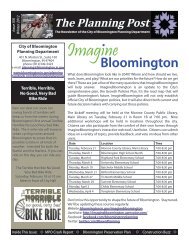Peak Oil Task Force Report - City of Bloomington - State of Indiana
Peak Oil Task Force Report - City of Bloomington - State of Indiana
Peak Oil Task Force Report - City of Bloomington - State of Indiana
Create successful ePaper yourself
Turn your PDF publications into a flip-book with our unique Google optimized e-Paper software.
FOOD<br />
Eating <strong>Oil</strong><br />
Over the last 100 years, the way we feed ourselves has changed radically. Chiefly from the<br />
use <strong>of</strong> pesticides, herbicides, fertilizers, and mechanization, agricultural production over<br />
the last century has more that tripled. However, the modern food system is both highly<br />
centralized and almost entirely dependent on oil. It relies on oil both for production and for<br />
transportation from farm to table. Indeed, little more than 2 percent <strong>of</strong> the food we eat<br />
comes from local sources. Our food travels thousands <strong>of</strong> miles on average, most <strong>of</strong> it is<br />
carried by diesel‐powered trucks. 220 As <strong>Bloomington</strong> consumers, we complete deliveries to<br />
the kitchen by commuting from our homes to half a dozen shopping hubs at major traffic<br />
junctures to the north, south, east, and west <strong>of</strong> the city center.<br />
This system <strong>of</strong> production and<br />
consumption is a very energy<br />
intensive one. Approximately 7.3<br />
calories <strong>of</strong> fossil energy go into<br />
harvesting and serving up one<br />
calorie <strong>of</strong> solar‐derived food<br />
energy. 221 Of this total, 1.6 calories<br />
go into farm operations, transport<br />
requires 1.0 calorie, processing<br />
and packaging require 1.7<br />
calories, retail sales and food<br />
Source: Woodrow Wilson International Center for Scholars<br />
service 0.8 calories, and household level storage and preparation 2.3 calories. Most<br />
Americans are literally eating oil and gas (and not a little coal).<br />
220 It is fair to assume that <strong>Bloomington</strong> foodmiles do not differ that much from the national average. Produce<br />
in the U.S. travels, on average, 1300 ‐ 2000 miles from farm to consumer.<br />
221 Richard Heinberg and Michael Bomford, The Food and Farming Transition: Toward a PostCarbon Food<br />
System, Post Carbon Institute, 2009. http://www.postcarbon.org/food<br />
<strong>Report</strong> <strong>of</strong> the <strong>Bloomington</strong> <strong>Peak</strong> <strong>Oil</strong> <strong>Task</strong> <strong>Force</strong> 173









